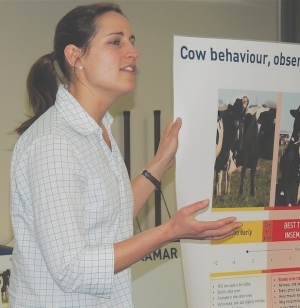With practice, maybe, but given the paper and told to go for it, few can, and so it is with mating management on a dairy farm; trouble is, missing that target costs $200 per cow, per heat missed.
Dairy NZ consulting officer Erin Sinclair used the analogy at one of a series of mating workshops the levy body has been running around the country.
“The end result was a few [of the darts] worked but there was a big range in performance,” she pointed out.
Had the dart makers been selected for their skills, briefed on what was required, and given some time to practice, and, if necessary, tuition, a lot more darts would have hit the mark, she explained.
And so it is with mating management on a dairy farm. Pre-mating is the ideal time to make sure the team know why accurate heat detection is important, and how to do it because “there’s nothing riding on it.”
“Getting someone to explain what they’re doing and why is a good way to check [skills]…. Doing it during mating is a wee bit late because we know every missed heat costs at least $200 in lost production.”
Sinclair added farm staff should be made aware that better mating management will mean a tighter, easier to manage calving for them the following spring, and hopefully a break between calving and start of mating.
Fellow presenter Amy Horrell, of LIC, suggested occasionally stopping the platform in rotary sheds and asking staff “would you, or wouldn’t you, put her up for mating?”
Some farms put photos on the shed wall to establish standards on how much tail paint they expect to see rubbed off if a cow’s on heat, she added.
Besides getting the team’s eyes in ahead of the real thing, recording pre-mating heats will help identify non-cyclers so interventions can be considered and, come mating, the date of a pre-mating heat provides a cross-check on cows where there’s doubt about whether or not they’re on heat.
Even for experienced staff, because the AB season is only for a few weeks a year it’s worth running a refresher to ensure everyone’s up to speed, said Horrell, and having a back-up plan in case the main person responsible for heat detection is unavailable.
Using at least two forms of heat detection is advisable: tailpaint or other form of heat detector plus observation in the paddock for example, “especially for that second round of AB when everyone’s getting tired.”
Heat detectors and/or tail paint need to be applied correctly – with Kamars the arrow must point to the animal’s head and be in the right place – and in the right place allowing for the size of the cow. Tail paint needs to be worked into the hair and regularly touched up. “Wait a day if it’s raining.” Trim hair to 1-2cm and warm glue so heat detectors stick well.
Observation in the paddock should be mid-way between milkings not immediately after (all eating) or immediately before when cows will be queuing to get to the shed.
Cows on heat will be in sexually active groups (SAG) riding each other, often around the water trough, though sometimes younger, less dominant cows are harder to spot as they are only on the fringe of such activity.
Even if a cow isn’t spotted in a SAG in the paddock, there are other tell-tale signs such as mud marks down the flanks, restlessness, poor milk letdown and mucus around the vulva. A system is needed to ensure team members communicate such observations effectively to whomever is in the shed and the cows get checked and drafted accordingly.
If in doubt about a cow, draft anyway then observe how she behaves with the other cows on heat. If she stands off from the group, put her back with the herd and don’t serve. If she’s on heat, she’ll be mixing it with the rest of them, suggested Horrell’s colleague Andrea Dixon.

















